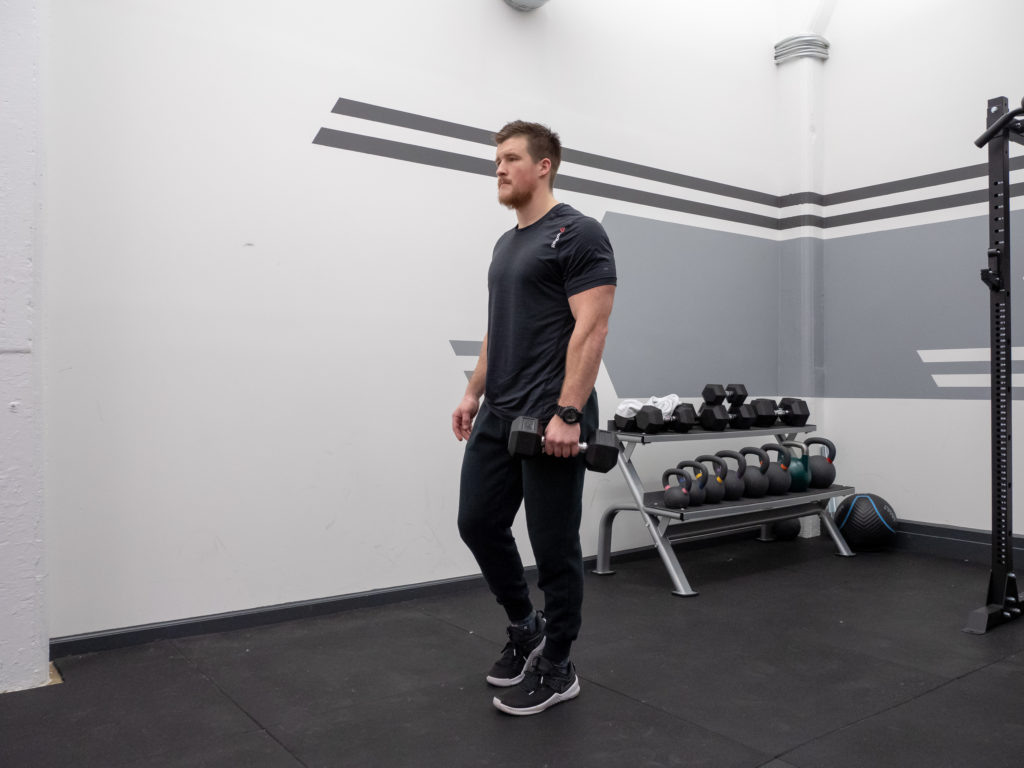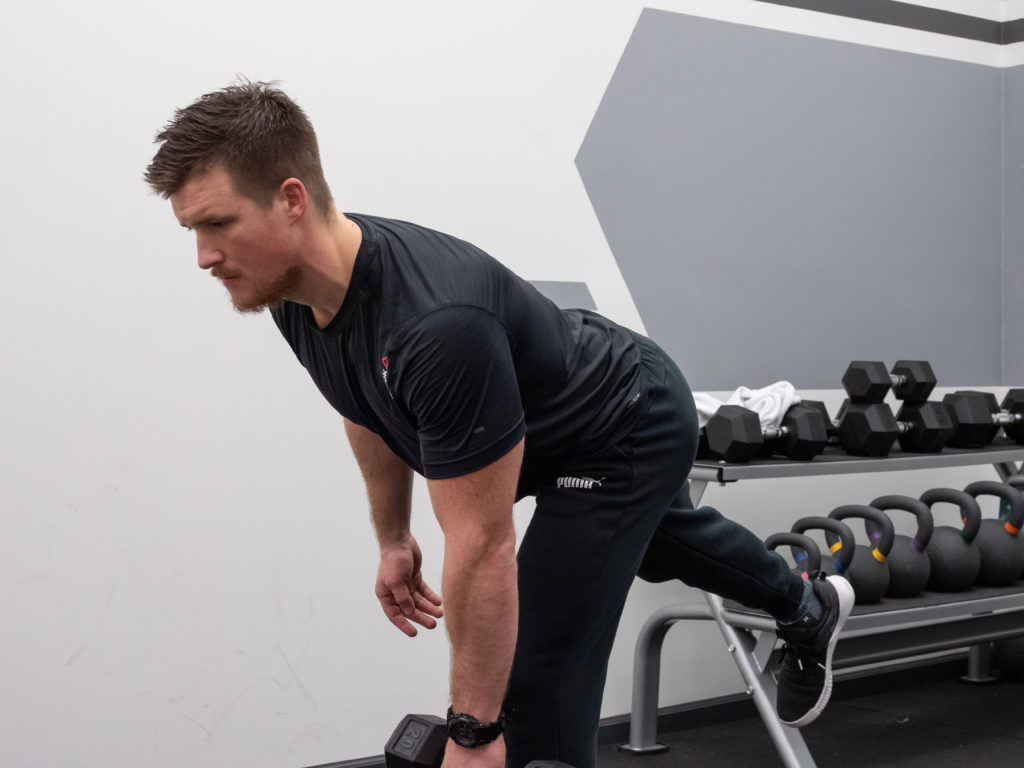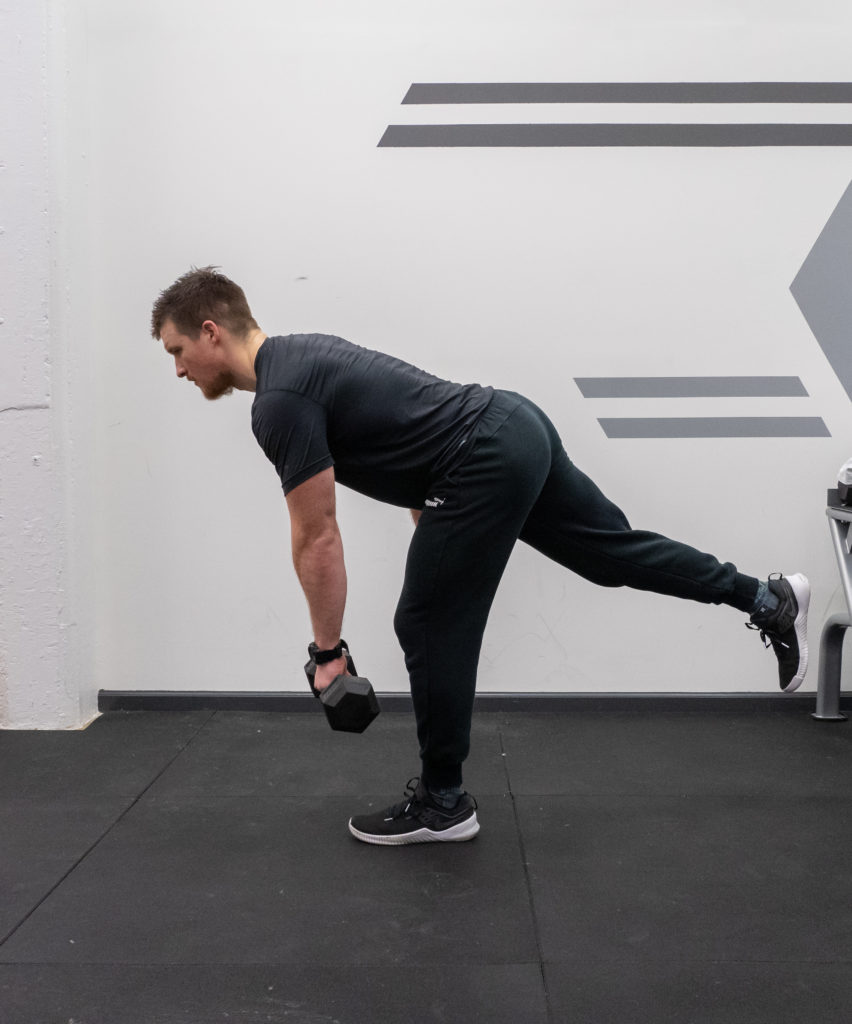Nearly every athlete can benefit from performing unilateral leg training. Increased neuromuscular control, joint and muscular function, and muscular hypertrophy and endurance are just a few of the expected positive outcomes of including such movements (like the single leg Romanian deadlift) into training programs
Therefore, in this article we will discuss how to properly perform single leg Romanian deadlifts, what progressions and adjustments can be made, and why they are important for optimal hip function.
How to Perform the Single Leg Romanian Deadlift: Step-By-Step Guide
The below step-by-step guide discusses how to perform the single leg Romanian deadlift. It is important to note that these can be performed with a barbell, dumbbells, kettlebells, and many other external forms of loading.
Step 1. Stand on One Leg
Pick one foot up off the floor, finding balance on your grounded foot
Be sure to kept the ribs down and the pelvis facing forward. You can have a slight bend in the base knee (left knee in the below image). This will allow for a smoother transition into step 2.

Step 2. Push Your Hips Back
Push you hips back similarly to a two-legged (bilateral) deadlift. The key is to not allow the hip to rotate upwards (right hip turning up in the picture).
The belly button should be facing the floor, with the left knee bieng slightly bent.

Step 3. Stabilize and Come Up
Once you have established a stretch on the hamstring, be sure to come up under control. Resist the urge to lose spinal/back/hip integrity once you have reached the bottom.
Keep the back flat and load the hamstrings. When ready to return to the top, flex the glutes as hard as possible.

4 Benefits of the Single Leg Romanian Deadlift
Below are four main benefits of the single leg deadlift for all athletes, regardless of sports. Application to sport may be higher (runners and sprinters) than others (weightlifters), however that doesn’t not mean coaches and/or athletes should neglect basic human movement patterning. Even the smallest of frequency and training volume can play a huge role in improving hip and spine mechanics during most movements and enhance injury resilience.
1. Correct Asymmetries
Whether used as a primer exercise or corrective movement, this unilateral deadlift variation will uncover any movement asymmetries between each side of the body. If an athlete has a disconnect that is causing hip shifting in the squat and/or pulls, or have movement limitations in one leg more than the other; this may be a good option to re-teach a fundamental movement. Lastly, for locomotion sports (running and formal athletics) the mechanics of the lower limbs are generally done with one leg (at max) being asked to support the entire body throughout dynamic movement making this a great exercise to prevent movement disorders.
2. Muscular Strength and Endurance
This unilateral deadlift variation is a great way to increase muscular hypertrophy and endurance in the hamstrings and glutes. Additionally, this exercise can be build in to increase training volume to get beginners more apt to locate and activate their hamstrings and limit the amount of lumbar extension occurring during most pulling and hip hinging (flexion and extension) movements.
3. Balance and Stability
The ankle, knee, hip, and spine must coordinate stable and dynamic movement throughout the movement in an unstable environment, making the complexity much harder than a standard Romanian deadlift. The added benefit of balance training, intrinsic foot coordination and strength, ankle and knee stabilization, and hip function make this a great exercise for assessing lower body balance and stability as well.
4. Application to Sport
Whether you are a weightlifter, powerlifter, strongman, fitness athlete, or formal sports athlete, this exercise can used to increase movement patterning for nearly every pulling movement, increase joint and movement integrity, and bulletproof your body. Incorporating these into your training can be as simple as adding them to your movement prep, warm up, or assistance work.
Muscles Worked – Single Leg Romanian Deadlift
Below are the key muscle group trained when performing the single leg Romanian deadlift. This unilateral variation of the standard Romanian deadlift is often performed with lighter loads and requires greater balance and stability.
- Hamstrings
- Gluteal
- Calves and Ankle Stabilizers
- Obliques (core and pelvic stability)
Who Should Perform Single Leg Romanian Deadlifts?
The single leg Romanian deadlift is a unilateral lower body exercise that can help increase hamstring and glute health, improve joint function at the hip, and reinforce proper hamstring engagement; all of which can positively impact bilateral strength, powerformance, and health.
Strength and Power Athletes
Strength and power athletes can benefit from increased unilateral strength and performance as it can improve muscle health and overall performance during bilateral movements, like deadlifts.
- Powerlifters and Strongman Athletes: Both of these athletes rely heavily on the hamstrings and posterior chain for pulling strength and performance. The single leg Romanian deadlift is a good unilateral exercise to help improve hamstring health, increase muscle hypertrophy, and promote symmetrical movement patterning.
- Olympic Weightlifters: Improving hamstring health can aid in pulling strength, hip function, and longevity in the sport; similar to that of powerlifting and strongman athletes.
General and Functional Fitness
In addition to the above benefits, Increased hamstring health and development via unilateral training can help to produce stronger bilateral movements, correct movement asymmetries, and decrease the likelihood of injury.

Single Leg Romanian Deadlifts Sets, Reps, and Programming Recommendations
Below are three (3) primary training goals and programming recommendations when programming single leg Romanian deadlifts into training programs.
Movement Integrity – Reps and Sets
Below are sets and repetition recommendations to improve balance and stability in this unilateral movement.
- 4-6 sets of 5-8 repetitions
- It can be helpful to have the lifter hold a PVC pipe along their back (spine angle) to help them maintain a flat back and force proper hip hinging.
Hypertrophy – Reps and Sets
Below are sets and repetition recommendations to improve hamstring hypertrophy and development.
- 5-10 sets of 8-15 repetitions
- The rear-foot elevated variation is particularly great at increased hypertrophy as it allows for more loading ot be used (less balance needed) however still trains the hamstring in a unilateral manner.
Strength – Reps and Sets
While maximal strength training using unilateral exercises can be slightly riskier, some coaches can train the hamstring in a slightly heavier manner with more advanced athletes.
- 4-6 sets of 3-8 repetitions
- Never sacrifice range of motion or spinal integrity for loading. If the goal is maximal hamstring and posterior chain strength, stick with bilateral movements until you have fully developed stability and unilateral coordination/strength. That said, you can still train with loading on a unilateral basis (and you should), however choose more manageable loads (see above hypertrophy section).
Single Leg Romanian Deadlift Variations
Below are three (3) single leg Romanian deadlift variations that can be done to improve strength, size, and overall muscle growth
1. Eccentric Single Leg Romanian Deadlifts
The eccentric SL RDL is a movement that can be done to increase eccentric strength and muscle coordination on a unilateral basis. While the eccentric aspect can be trained during a regular SL RDL, the added emphasis on the eccentric lowering of the load can create significant muscle damage and increase muscle hypertrophy.
2. Tempo Single Leg Romanian Deadlift
Adding a tempo to the movement can be done to increase time under tension, enhance concentric, isometric and eccentric muscle coordination, and improve overall movement awareness and patterning of a lifter.
3. Rear-Foot Elevated Single Leg Romanian Deadlift
By elevating the rear foot on a low box or bench, you enable the lifter to still primarily work the front/base leg in a unilateral manner.
Single Leg Romanian Deadlift Alternatives
Below are three (3) single leg Romanian deadlift alternatives that can be done to vary programming, challenge lifters, and more.
1. One Leg Stiff Leg Deadlift
This is very similar to the SL RDL, however has the lifter place the knee in a less flexed position. In doing so, you can increase loading onto the hamstrings, however the one-leg stiff leg deadlift does require greater flexibility in the hamstring and hip.
2. Single Leg Hip Thrust
The single leg hip thrust is a unilateral glute exercise that can be done develop greater glute engagement and hip flexion/extension abilities. Often, lifters may not be able to properly hinge at the hips, making the single leg hip thrust a good regression to program to develop such abilities.
3. GHD
The glute ham developer can be done unilaterally or bilateral, and targets the same muscle groups as the single leg Romanian deadlift. This exercise also highly enforces the eccentric strength and coordination of the muscle.
Final Words
To help facilitate sound movement patterning, joint integrity, and optimal functioning of the muscles during complex movements, unilateral training exercises like the single leg Romanian deadlift can be trained. Coaches and athletes should never sacrifice movement mechanics for loading, especially in movement based exercises such as this.
Featured Image: Mike Dewar